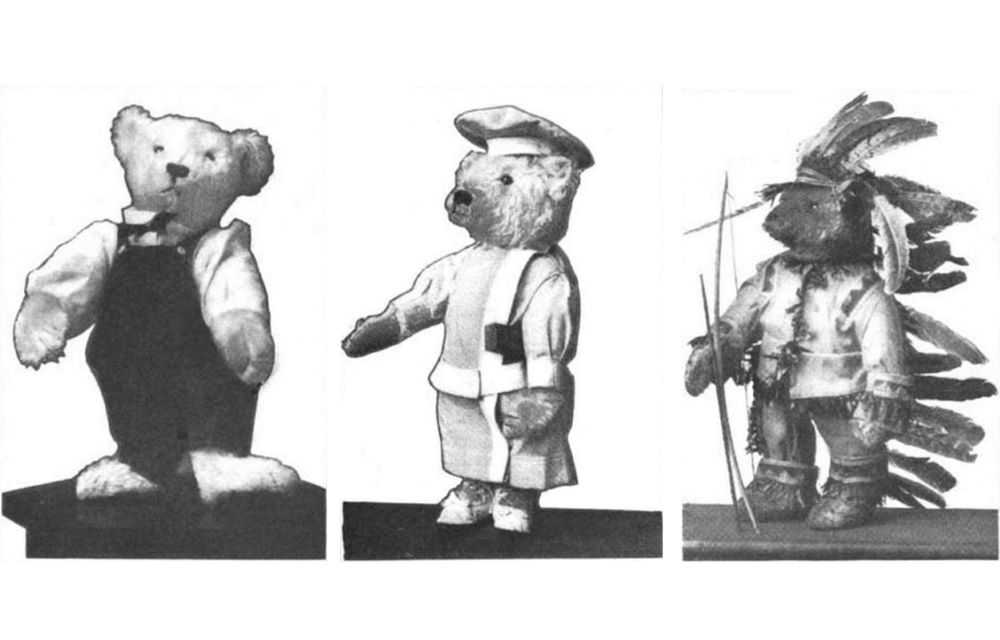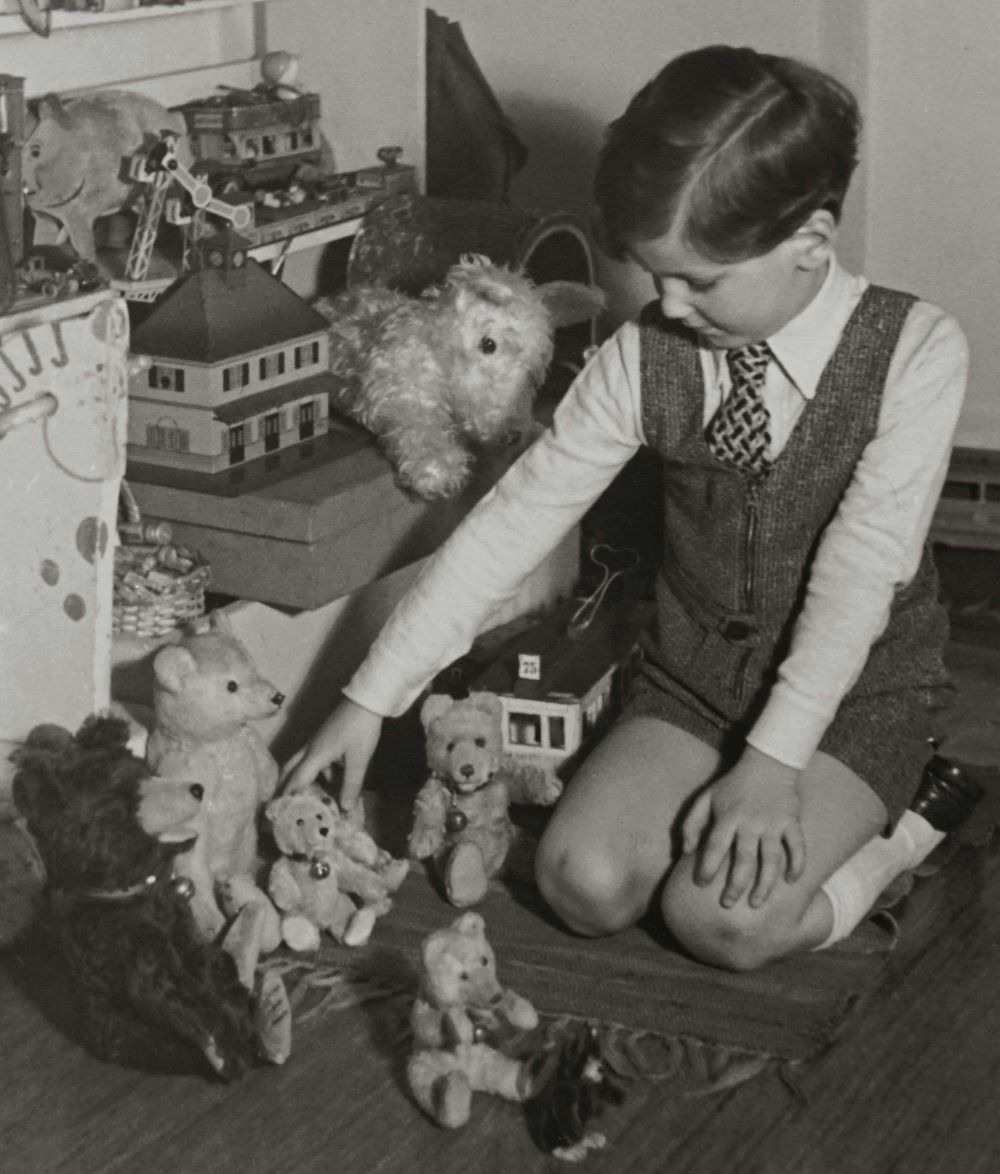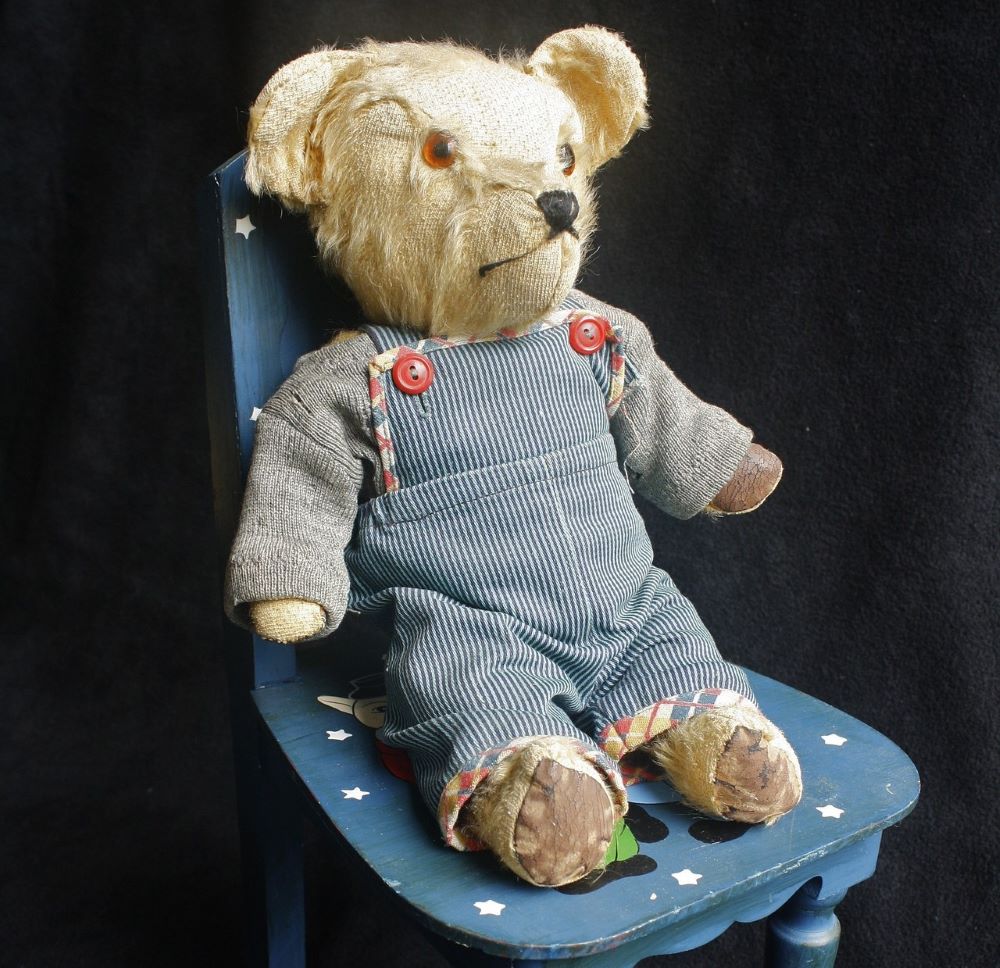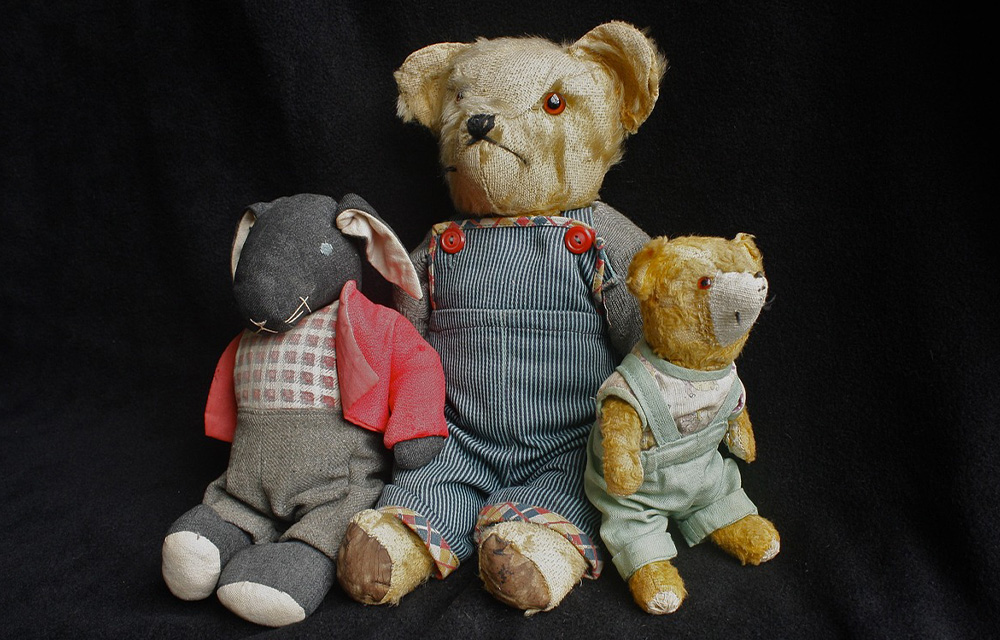Welcome to the third and final part of our comprehensive vintage teddy bear identification guide. In this segment, we delve into detailed case studies of some of the most iconic vintage teddy bears from renowned manufacturers like Steiff, Merrythought, Chad Valley, and more.
By examining these case studies, you’ll gain valuable insights into the unique features, historical contexts, and identifying marks that help authenticate and date these cherished collectibles.
We’ll also cover essential tips for the proper care and preservation of your vintage teddy bears, ensuring they remain in pristine condition for generations to come. Join us as we explore the fascinating world of vintage teddy bear identification!

In Part 1 we explored the intricacies of reading and interpreting tags, an essential skill for any serious collector. Understanding the unique features and variations in tags can significantly aid in accurately dating and authenticating your beloved bears.
In Part 2, we uncovered tips and tricks for spotting fake or reproduction vintage teddy bears. We discovered understanding the difference between an authentic treasure and a convincing copy.
Let’s delve into identifying antique teddy bears with tips on proper storage and care.
Case Studies in Vintage Teddy Bear Identification
Examining specific case studies of vintage teddy bears can provide valuable insights into the identification process.
By analyzing the unique features, and historical context, and identifying marks of well-known vintage bears, collectors can learn how to authenticate and date their own bears. Here are some detailed case studies of notable vintage teddy bears:

1. Steiff Teddy Bears
Case Study: The Steiff “Teddy Girl” Bear
- Background: The Steiff “Teddy Girl” is one of the most famous teddy bears in history. Owned by Colonel Bob Henderson, a British Army officer, this bear was his constant companion throughout World War II.
- Identifying Features:
- Button in Ear: Steiff’s signature “button in ear” trademark is present. Early Steiff buttons were made of nickel or brass and featured an elephant symbol.
- Material: Made from high-quality mohair, typical of early 20th-century Steiff bears.
- Jointed Limbs: The bear has jointed limbs and a head, allowing for movable parts.
- Eyes: The bear has boot-button eyes made of glass.
- Significance: The “Teddy Girl” bear set a world record when it was sold at auction for £110,000 in 1994. This case study highlights the importance of provenance and condition in the valuation of vintage bears.
Case Study: The Steiff “PB28” Bear
- Background: The “PB28” is one of the earliest teddy bears produced by Steiff, dating back to 1904.
- Identifying Features:
- Button in Ear: The bear features a metal button in its ear, an early hallmark of Steiff bears.
- Material: Made from felt and mohair, with wood-wool stuffing.
- Construction: The bear is rod-jointed, an early design feature.
- Eyes: Glass eyes are present, characteristic of early Steiff bears.
- Significance: The “PB28” is a rare example of Steiff’s early work and is highly valued by collectors. This bear represents the transition from Steiff’s initial felt animals to their iconic mohair teddy bears.
2. Merrythought Teddy Bears
Case Study: The Merrythought “Mr. Whoppit” Bear
- Background: “Mr. Whoppit” is a famous British teddy bear produced by Merrythought. It became iconic as the mascot of British racing driver Donald Campbell.
- Identifying Features:
- Label: The bear has a cloth label sewn into its paw with the Merrythought name and “Made in England.”
- Material: Made from synthetic plush, typical of mid-20th-century bears.
- Design: The bear has jointed limbs and a stitched nose and mouth.
- Provenance: Known for its association with Donald Campbell, who carried “Mr. Whoppit” during his record-breaking speed attempts.
- Significance: The association with Donald Campbell enhances the bear’s historical significance and value. This case study illustrates the impact of notable ownership on the collectibility of vintage bears.
3. Chad Valley Teddy Bears
Case Study: The Chad Valley “Hygienic Toys” Bear
- Background: Chad Valley was a prominent British toy manufacturer known for its high-quality teddy bears.
- Identifying Features:
- Label: The bear has a fabric label sewn into its side with the words “Chad Valley Hygienic Toys Made in England.”
- Material: Made from mohair with wood wool stuffing.
- Construction: The bear has jointed limbs and a head, with glass eyes.
- Design: Typically has a more robust and chunky design compared to other manufacturers.
- Significance: Chad Valley bears are known for their durability and quality. The “Hygienic Toys” label indicates a focus on safety and quality, which was a significant selling point during the mid-20th century.
4. Ideal Novelty and Toy Company Bears
Case Study: The Ideal “Teddy Bear”
- Background: The Ideal Novelty and Toy Company, based in the USA, produced some of the first teddy bears in the early 1900s.
- Identifying Features:
- Label: Early Ideal bears often had sewn-in labels with the company name and logo.
- Material: Made from high-quality mohair with wood-wool stuffing.
- Construction: The bear features jointed limbs and a head, with glass eyes.
- Design: Ideal bears often have distinctive, well-defined snouts and a robust build.
- Significance: Ideal bears were among the first teddy bears produced in the USA, making them highly collectible. Their historical significance and association with the origins of the teddy bear add to their value.
5. Hermann Teddy Original Bears
Case Study: The Hermann “Teddy Bear”
- Background: Hermann Teddy Original, based in Germany, is known for its traditional German craftsmanship.
- Identifying Features:
- Label: The bear has a sewn-in label with the Hermann logo and “Made in Germany.”
- Material: Made from high-quality mohair with excelsior stuffing.
- Construction: Features jointed limbs and head, with glass eyes.
- Design: Hermann bears often have a more delicate and detailed facial design compared to other brands.
- Significance: Hermann bears are valued for their craftsmanship and attention to detail. They represent the high standards of German teddy bear production.
6. Dean’s Rag Book Company Bears
Case Study: The Dean’s “Rag Book” Bear
- Background: Dean’s Rag Book Company, established in the UK, is one of the oldest teddy bear manufacturers.
- Identifying Features:
- Label: Early Dean’s bears have a cloth label sewn into the bear’s foot or side, often with the company name and “Made in England.”
- Material: Made from mohair with wood wool stuffing.
- Construction: The bear has jointed limbs and a head, with glass eyes.
- Design: Dean’s bears are known for their whimsical and often colorful designs.
- Significance: Dean’s bears are highly collectible due to their age and the company’s long history in toy manufacturing. Their unique designs and high-quality construction make them stand out in collections.
Studying specific case studies of vintage teddy bears can provide invaluable insights into the identification and valuation process.

By examining the unique features, materials, construction, and historical context of these bears, collectors can develop a keen eye for authenticity.
Understanding the significance of identifying marks and labels, as well as the impact of provenance, can help ensure that your collection remains genuine and historically valuable.
Caring for and Preserving Vintage Teddy Bears
Proper Cleaning and Maintenance
Caring for vintage teddy bears is essential to maintain their value and appearance. Here are some tips for proper cleaning and maintenance:
- Dust Removal: Use a soft brush, such as a makeup brush or a dedicated teddy bear brush, to gently remove dust and dirt from the bear’s fur. Brush in the direction of the fur to avoid damaging the fibers.
- Spot Cleaning: For minor stains, use a damp cloth with mild soap and water to gently dab the affected area. Avoid soaking the bear or using harsh chemicals, which can damage the fabric and colors.
- Deep Cleaning: If your bear needs a more thorough cleaning, consider consulting a professional teddy bear restorer. They have the expertise and tools to clean delicate materials without causing harm.
- Avoid Moisture: Keep your teddy bear dry. Excess moisture can lead to mold and mildew growth, which can be difficult to remove and harmful to the bear’s materials.
- Repairing Tears: If your bear has any tears or loose seams, use a needle and thread to carefully stitch them up. For significant damage, seek professional restoration services.
Storage Tips
Proper storage is crucial to preserving the condition and longevity of vintage teddy bears:
- Climate Control: Store your teddy bears in a cool, dry place. Avoid areas with high humidity or extreme temperatures, which can damage the materials.
- Sunlight Protection: Keep bears away from direct sunlight, as UV rays can fade the fur and fabrics over time. A shaded or dimly lit area is ideal for storage.
- Wrapping: Use acid-free tissue paper to wrap your bears. Acid-free materials prevent chemical reactions that can cause discoloration or degradation of fabrics over time. Wrap each bear individually to provide a protective barrier.
- Avoid Stacking: Do not stack teddy bears on top of each other, as this can cause crushing and deformities. Store them upright or lying flat, ensuring they are not under pressure from other objects.
- Display Cases: If you prefer to display your bears, use glass display cases to protect them from dust and handling. Ensure the cases are well-ventilated to prevent moisture buildup.
Additional Tips
- Regular Inspections: Periodically check your bears for signs of damage, such as loose joints, tears, or pest infestations. Early detection allows for timely repairs and prevents further deterioration.
- Handling: When handling vintage bears, make sure your hands are clean and dry to avoid transferring oils and dirt to the fabric. Consider wearing cotton gloves for added protection.
By following these cleaning and storage tips, you can ensure that your vintage teddy bears remain in excellent condition for years to come, preserving their beauty and value for future generations to enjoy.
Conclusion
Identifying vintage teddy bears can be a rewarding endeavor. By understanding their history, recognizing key features, and utilizing the right resources, you can become an expert in vintage teddy bear identification.
Remember to preserve your bears carefully, using proper cleaning and storage techniques to maintain their value and condition.
Engage with fellow collectors and share your findings, as community knowledge can greatly enhance your expertise. Feel free to ask questions and share your experiences in the comments below. Happy collecting!

ID & Care FAQ
1. How can I identify a genuine vintage Steiff teddy bear?
Steiff bears have a signature “button in ear” — a small metal button with an elephant symbol. Also, look for materials like mohair, glass eyes, and jointed limbs typical of early Steiff bears.
2. What are the key features of Merrythought teddy bears?
They often have a cloth label sewn in with “Made in England.” The “Mr. Whoppit” bear is famous as the mascot of racer Donald Campbell, adding to its value.
3. How should I properly care for a vintage teddy bear?
Use a soft brush to gently remove dust following the direction of the fur. For light stains, dab gently with a damp cloth and mild soap. Avoid soaking or harsh chemicals.
4. How should I store vintage teddy bears to keep them in good condition?
Store them in a cool, dry place away from direct sunlight. Wrap each bear in acid-free tissue paper and avoid stacking to prevent crushing or deformation.
5. What should I do if my teddy bear has a tear or loose seam?
For minor damage, carefully sew it by hand. For serious damage, consider professional restoration services.
6. What are the signs that a vintage teddy bear might be a fake?
Missing brand marks (like the Steiff button), unusual materials, poor stitching quality, or overly bright/new-looking fabric can indicate a reproduction.
7. Why is it important to know the history and origin of a teddy bear?
Understanding its background helps properly assess its value. Famous owners and rare models greatly increase a teddy’s collectible worth.
Additional Resources
For more fascinating insights into the world of teddy bears, check out these articles:
- 10 of the Most Expensive Teddy Bears in the World: Discover some of the priciest teddy bears ever sold, and learn what makes them so valuable.
- Peering into Celebrities and Their Beloved Teddy Bear Collections and Connections: Explore the unique teddy bear collections of famous personalities and their deep connections to these cherished toys.
- Teddy Bear Auctions: Where to Find Celebrity-Owned Collectibles: Get tips on where to find teddy bears previously owned by celebrities, and learn about upcoming auctions featuring these rare collectibles.
Get Free Patterns & Be the First to Know!
Want free teddy bear patterns, exclusive tutorials, and a chance to win craft supplies?
Sign up for our newsletter using the subscribe form in the middle of this article to receive new patterns, insider tips, and the latest news on teddy bear art. You’ll also automatically be entered into our annual giveaway for a chance to win teddy bear crafting materials.
Bonus entry: Save one of our pins on Pinterest to increase your chances of winning!
Let’s create, inspire, and craft beautiful teddy bears together!


Hi
what a fun read and very knowledgable about the vintage bear there where a few great parts in this article. I really enjoyed the part on : Case Studies in Vintage Teddy Bear Identification – Steiff Teddy Bears this just blows my mind the history that was provided on this bear is fantastic I would of never guess that this bear was worth 110,000 that’s in out of this world if you ask me but so interesting at the same time.
so my question is :
where would that bear be today ? What do you think it would be worth now ?
get job on the article really enjoyed the read
Hi there,
I’m so glad you enjoyed the article! The history of vintage teddy bears, especially the iconic Steiff bears, is truly fascinating. It’s amazing how much value these adorable collectibles can hold.
Regarding your question, the Steiff teddy bear you’re referring to is likely one of the rare early editions, possibly even the famous “Teddy Girl” bear, which indeed fetched a whopping $110,000 at auction. These bears are often found in private collections, museums, or special exhibitions dedicated to vintage toys and teddy bears.
As for its current worth, the value of such rare and historic teddy bears tends to appreciate over time, especially if they are well-preserved and have a significant backstory. Given the continuing interest in antique collectibles, it’s possible that this bear could be worth even more today, potentially reaching upwards of $150,000 or more, depending on its condition and provenance.
Thanks again for your kind words about the article! If you have any more questions or just want to chat about teddy bears, feel free to reach out. Happy crafting!
Best,
Hanna
Hey Hanna,
I was thrilled to stumble upon this ultimate guide to vintage teddy bear identification! As a teddy bear enthusiast, I appreciate the in-depth tips and tricks shared in this article. The world of vintage teddy bears is filled with rich history and unique characteristics, and this guide does an excellent job of helping collectors and enthusiasts navigate the complexities of identifying these beloved toys.
Here are a couple of questions I have:
1. Are there any specific markings or features that are considered rare or highly sought after in vintage teddy bears?
2. Can you provide any insights or resources on how to properly care for and preserve vintage teddy bears to ensure their longevity?
Thank you for providing such valuable information for teddy bear lovers like myself. This guide is a treasure trove of knowledge and will surely enhance our appreciation for these timeless and cherished companions. Keep up the fantastic work!
Marios
Hi Marios,
I’m thrilled to hear that you enjoyed the ultimate guide to vintage teddy bear identification! It’s wonderful to connect with fellow teddy bear enthusiasts who share a passion for these charming companions.
Regarding your questions, certain characteristics can make a vintage teddy bear particularly valuable. Manufacturer labels and tags from renowned makers like Steiff, Merrythought, or Ideal are highly prized. Early Steiff bears often have a distinctive button in the ear with an elephant logo, which can significantly increase their value. Bears made from mohair or featuring jointed limbs, hand-stitched noses, claws, and glass eyes are typically more desirable. Bears in excellent condition with minimal wear and tear, as well as those with any original accessories or clothing, are always more valuable.
To ensure the longevity of your vintage teddy bears, it’s important to store them in a cool, dry place away from direct sunlight to prevent fading and deterioration. Handle your bears with clean hands to avoid transferring oils and dirt, and consider wearing gloves if you handle them frequently. For surface cleaning, use a soft brush to remove dust and avoid using water or harsh chemicals, as they can damage the material. If your bear needs repairs, seek out a professional restorer who specializes in vintage toys to ensure the work is done correctly without diminishing its value.
Thank you for your kind words and support! I’m so glad you found the guide helpful and insightful. Stay tuned for more articles and tips on all things teddy bears. Happy collecting!
Warm regards,
Hanna
Hi there
I just discovered your articles which are very informative. I now have the teddy bear ‘bug ‘ after having replaced paws and restitched features on a friends 1950’s teddy. In the last six months I have bought on eBay fourteen bears in various stages of decreptitude and brought them back to life. The first one was cleaned, restuffed with a kapok like stuffing and acrylic felt for paws. I have moved on since then, learned a lot and redone him with German wood wool and the best 100% wool felt ! I do keep original fillings now if possible. I absolutely love my new hobby. My husband is slightly unnerved as everywhere he goes he is watched by amber eyes ! Thanks again. Ann
Hello Ann! ?
Thank you so much for your comment and your kind words about our articles! We’re very happy to hear they have been helpful for you.
Your story about restoring teddy bears truly touched our hearts — so much love and care for each little bear! Using wood wool and natural wool felt is such a wonderful choice for restoration.
And yes, we completely understand — those amber eyes really do create a special atmosphere everywhere! ?
We wish you lots of joy and inspiration in your wonderful hobby! Feel free to share your projects with us — we would love to hear more! ??